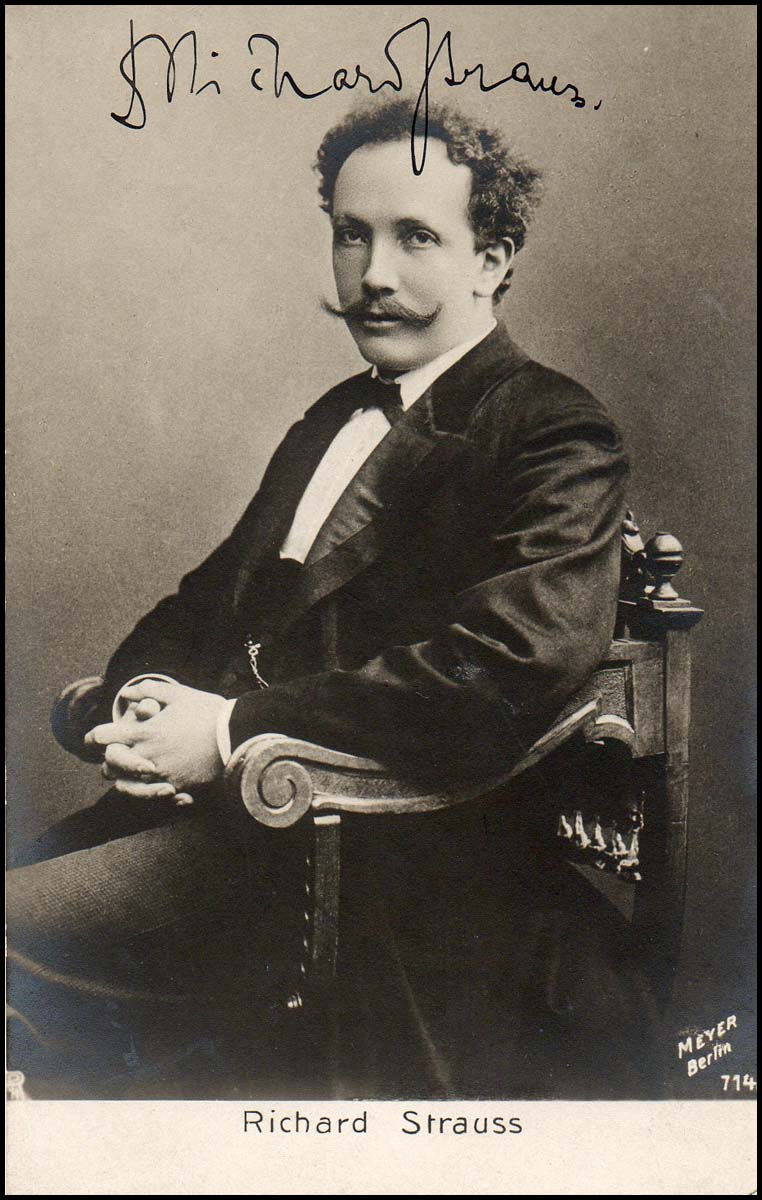- Profession: Conductor, composer.
- Residences: Munich, Berlin
- Relation to Mahler: As director of the Vienna State Opera, Mahler defended the spicy and graphic Salome when the censors prevented it. Strauss returned the favor by programming Mahler’s symphonies wherever he went. Mahler said: “Strauss and I tunnel from the opposite sides of the mountain. One day we will meet.” First meeting with Gustav Mahler 13-10-1887 in Leipzig.
- Relation to Willem Mengelberg (1871-1951): Friend, Mengelberg invited Strauss often to visit Amsterdam. They shared a passion for art, crafts and antiques. In particular, porcelain and glassware.
- Correspondence with Mahler: Yes.
- Born: 11-06-1864 Munich, Germany.
- Died: 08-09-1949 Garmisch-Partenkirchen, Germany. Aged 85.
- Buried: His ashes were kept at the Richard Strauss Villa in Garmisch. After the death of his son in 1980 they were interred in the Garmisch cemetery.
Richard Georg Strauss was a leading German composer of the late Romantic and early modern eras. He is known for his operas, which include Salome (Year 1905) and Der Rosenkavalier (Year 1911); his lieder, especially his Four Last Songs (1948); his tone poems, including Don Juan (Year 1888), Death and Transfiguration (Year 1889), Till Eulenspiegel’s Merry Pranks (Year 1895), Also sprach Zarathustra (Year 1896), Ein Heldenleben (Year 1898), Symphonia Domestica (Year 1903), and An Alpine Symphony (1915); and other instrumental works such as Metamorphosen and his Oboe Concerto. Strauss was also a prominent conductor throughout Germany and Austria.
Strauss, along with Gustav Mahler, represents the late flowering of German Romanticism after Richard Wagner, in which pioneering subtleties of orchestration are combined with an advanced harmonic style.
Early life and family
Strauss was born on 11 June 1864 in Munich, the son of Josephine (née Pschorr) and Franz Strauss, who was the principal horn player at the Court Opera in Munich. In his youth, he received a thorough musical education from his father. He wrote his first composition at the age of six, and continued to write music almost until his death.
During his boyhood Strauss attended orchestra rehearsals of the Munich Court Orchestra (now the Bavarian State Orchestra), and he also received private instruction in music theory and orchestration from an assistant conductor there. In 1872 he started receiving violin instruction at the Royal School of Music from Benno Walter, his father’s cousin. In 1874 Strauss heard his first Wagner operas, Lohengrin and Tannhäuser. The influence of Wagner’s music on Strauss’s style was to be profound, but at first his musically conservative father forbade him to study it. Indeed, in the Strauss household, the music of Richard Wagner was viewed with deep suspicion, and it was not until the age of 16 that Strauss was able to obtain a score of Tristan und Isolde. In later life, Strauss said that he deeply regretted the conservative hostility to Wagner’s progressive works. Nevertheless, Strauss’s father undoubtedly had a crucial influence on his son’s developing taste, not least in Strauss’s abiding love for the horn.
In early 1882 in Vienna he gave the first performance of his Violin Concerto in D minor, playing a piano reduction of the orchestral part himself, with his teacher and “cousin” Benno Walter as soloist. The same year he entered Ludwig Maximilian University of Munich, where he studied Philosophy and Art History, but not music. He left a year later to go to Berlin, where he studied briefly before securing a post as assistant conductor to Hans von Bülow, who had been enormously impressed by the young composer’s Serenade for wind instruments, composed when he was only 16 years of age. Strauss learned the art of conducting by observing Bülow in rehearsal. Bülow was very fond of the young man and decided that Strauss should be his successor as conductor of the Meiningen orchestra when Bülow resigned in 1885. Strauss’s compositions at this time were indebted to the style of Robert Schumann or Felix Mendelssohn, true to his father’s teachings. His Horn Concerto No. 1, Op. 11, is representative of this period and is a staple of modern horn repertoire.
Strauss married soprano Pauline de Ahna on 10 September 1894. She was famous for being irascible, garrulous, eccentric and outspoken, but the marriage, to all appearances, was essentially happy and she was a great source of inspiration to him. Throughout his life, from his earliest songs to the final Four Last Songs of 1948, he preferred the soprano voice to all others, and all his operas contain important soprano roles.
The Strausses had one son, Franz, in 1897. Franz married Alice von Grab, a Jewish woman, in a Catholic ceremony in 1924. Franz and Alice had two sons, Richard and Christian.
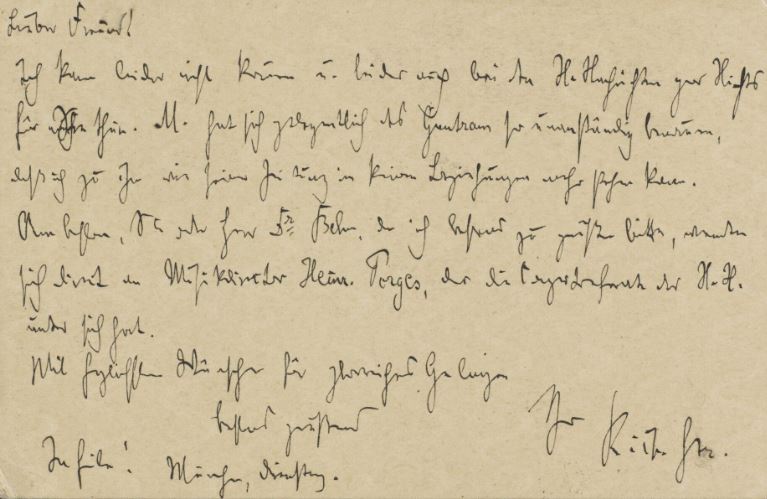
Year 1895. Letter by Richard Strauss (1864-1949) to Gustav Mahler (1860-1911) ‘Lieber Freund’. Explaining that he cannot help him over Guntram, since Munich has behaved so badly over the opera, that he feels he has no influence there, advising him to write in person to the conductor Heinrich Porges, who acts as the concert adjudicator there, 1 page, on a postcard, oblong 8vo, autograph address panel on verso, postmarked: Munich, 10 December 1895 (10-12-1895).
Solo and chamber works
Some of Strauss’s first compositions were solo and chamber works. These pieces include: early compositions for piano solo in a conservative harmonic style, many of which are lost; a string quartet (opus 2); a cello sonata; a piano quartet; Violin Sonata in E flat (1888); as well as a handful of late pieces.
After 1890 Strauss composed very infrequently for chamber groups, his energies being almost completely absorbed with large-scale orchestral works and operas. Four of his chamber pieces are actually arrangements of portions of his operas, including the Daphne-Etude for solo violin, and the string Sextet which is the overture to his final opera Capriccio. His last independent chamber work, an Allegretto in E for violin and piano, dates from 1940.
Tone poems and other orchestral works
Strauss’s style began to truly develop and change when, in 1885, he met Alexander Ritter, a noted composer and violinist, and the husband of one of Richard Wagner’s nieces. It was Ritter who persuaded Strauss to abandon the conservative style of his youth, and begin writing tone poems. He also introduced Strauss to the essays of Richard Wagner and the writings of Arthur Schopenhauer. Strauss went on to conduct one of Ritter’s operas, and at Strauss’s request Ritter later wrote a poem describing the events depicted in Strauss’s tone poem Death and Transfiguration.
The new influences from Ritter resulted in what is widely regarded as Strauss’s first piece to show his mature personality, the tone poem Don Juan (1888), which displays a new kind of virtuosity in its bravura orchestral manner. Strauss went on to write a series of increasingly ambitious tone poems: Death and Transfiguration (1889), Till Eulenspiegel’s Merry Pranks (1895), Thus Spoke Zarathustra (1896), Don Quixote (1897), Ein Heldenleben (1898), Symphonia Domestica (1903) and An Alpine Symphony (1911-1915). One commentator has observed of these works that “no orchestra could exist without his tone poems, written to celebrate the glories of the post-Wagnerian symphony orchestra.”
06-1901, Year 1901. Letter received by Gustav Mahler (1860-1911) from Richard Strauss (1864-1949).
James Hepokoski notes a shift in Strauss’s technique in the tone poems, occurring between 1892 and 1893. It was after this point that Strauss rejected the philosophy of Schopenhauer, and began more forcefully critiquing the institution of the symphony and the symphonic poem, thereby differentiating the second cycle of tone poems from the first.
Solo instrument with orchestra
Strauss’s output of works for solo instrument or instruments with orchestra was fairly extensive. The most famous include two concertos for horn, which are still part of the standard repertoire of most horn soloists; a Violin Concerto in D minor; the Burleske for piano and orchestra; the tone poem Don Quixote for cello, viola and orchestra; the well-known late Oboe Concerto in D major; and the Duet-Concertino for bassoon, clarinet and orchestra, which was one of his last works (1947).
Opera
Around the end of the 19th century, Strauss turned his attention to opera. His first two attempts in the genre, Guntram (1894) and Feuersnot (1901), were controversial works: Guntram was the first significant critical failure of Strauss’s career, and Feuersnot was considered obscene by some critics.
In 1905, Strauss produced Salome, a somewhat dissonant modernist opera based on the play by Oscar Wilde, which produced a passionate reaction from audiences. The premiere was a major success, with the artists taking more than 38 curtain calls. Many later performances of the opera were also successful, not only with the general public but also with Strauss’s peers: Maurice Ravel said that Salome was “stupendous”, and Mahler described it as “a live volcano, a subterranean fire”. Strauss reputedly financed his house in Garmisch-Partenkirchen completely from the revenues generated by the opera.
Strauss’s next opera was Elektra (1909), which took his use of dissonance even further, in particular with the Elektra chord. Elektra was also the first opera in which Strauss collaborated with the poet Hugo von Hofmannsthal. The two subsequently worked together on numerous occasions. For his later works with Hofmannsthal, Strauss moderated his harmonic language: he used a more lush, melodic late-Romantic style based on Wagnerian chromatic harmonies that he had used in his tone poems, with much less dissonance, and exhibiting immense virtuosity in orchestral writing and tone color. This resulted in operas such as Der Rosenkavalier (1911) having great public success. Strauss continued to produce operas at regular intervals until 1942. With Hofmannsthal he created Ariadne auf Naxos (1912), Die Frau ohne Schatten (1918), Die ägyptische Helena (1927), and Arabella (1932). For Intermezzo (1923) Strauss provided his own libretto. Die schweigsame Frau (1934), was composed with Stefan Zweig as librettist; Friedenstag (1935-1936) and Daphne (1937) both had a libretto by Joseph Gregor and Stefan Zweig; and Die Liebe der Danae (1940) was with Joseph Gregor. Strauss’s final opera, Capriccio (1942), had a libretto by Clemens Krauss, although the genesis for it came from Stefan Zweig and Joseph Gregor.
According to statistics compiled by Operabase, in number of operas performed worldwide over the five seasons from 2008/09 to 2012/13, Strauss was the second most-performed 20th-century opera composer; Puccini was the first and Benjamin Britten the third. Strauss tied with Handel as the eighth most-performed opera composer from any century over those five seasons. Over the five seasons from 2008/09 to 2012/13, Strauss’s top five most-performed operas were Salome, Ariadne auf Naxos, Der Rosenkavalier, Elektra, and Die Frau ohne Schatten.
Correspondence with Gustav Mahler
Gustav Mahler and Richard Strauss came to know one another as young conductors in Leipzig in 1887. From then until Mahler’s death in 1911 (the year of the first performance of Der Rosenkavalier) they kept in touch. Mahler himself described their relationship as that of two miners tunneling from opposite directions with the hope of eventually meeting.
This first publication of their correspondence, which includes twenty-five previously unknown Strauss letters, offers a portrait of two men who were as antithetical in their musical means and goals as in their temperaments and personalities, but who exercised a strong fascination for one another. These sixty-three letters show both composers advancing in their careers as they battled against adverse conditions in the musical world at the turn of the century. They present Mahler’s energetic support of Strauss’s Symphonia Domestica, which Mahler conducted in 1904 and, in turn, Strauss’s championing of Mahler’s music, especially the Second and Third Symphonies.
Strauss villa in Vienna (Richard-Strauss-Schlössel, III, Jacquingasse 8-10, now embassy building of the Netherlands)
The villa was built 1922-1926 by Michael Rosenauer on behalf of the city of Vienna, which she left to Richard Strauss as a gift.
First living at the Mozartplatz, Strauss was to receive the “Kammergarten” of the Belvedere for 90 years from the city of Vienna. After tough negotiations, however, Strauss acquired the property and built the Strauss villa.
Land and construction were financed by the sale of the original scores of the “Rosenkavalier”, “Schlagobers”, income from foreign tours and a loan from the family of his daughter-in-law. The three-storey villa presents itself with conservative historicist facade design, mansard roof and terrace.
Commemorative plaque with portrait relief.
Lieder and choral
All his life Strauss produced Lieder. The Four Last Songs are among his best known, along with Zueignung, Cäcilie, Morgen!, Allerseelen, and others. In 1948, Strauss wrote his last work, the Four Last Songs for soprano and orchestra. He reportedly composed them with Kirsten Flagstad in mind, and she gave the first performance, which was recorded. Strauss’s songs have always been popular with audiences and performers, and are generally considered by musicologists—along with many of his other compositions—to be masterpieces.
Strauss in Nazi Germany
Reichsmusikkammer
In March 1933, when Strauss was 68, Adolf Hitler and the Nazi Party rose to power. Strauss never joined the Nazi party, and studiously avoided Nazi forms of greeting. For reasons of expediency, however, he was initially drawn into cooperating with the early Nazi regime in the hope that Hitler—an ardent Wagnerian and music lover who had admired Strauss’s work since viewing Salome in 1907—would promote German art and culture. Strauss’s need to protect his Jewish daughter-in-law and Jewish grandchildren also motivated his behavior, in addition to his determination to preserve and conduct the music of banned composers such as Mahler and Debussy.
In 1933, Strauss wrote in his private notebook:
I consider the Streicher-Goebbels Jew-baiting as a disgrace to German honour, as evidence of incompetence—the basest weapon of untalented, lazy mediocrity against a higher intelligence and greater talent.
Meanwhile, far from being an admirer of Strauss’s work, Joseph Goebbels maintained expedient cordiality with Strauss only for a period. Goebbels wrote in his diary:
Unfortunately we still need him, but one day we shall have our own music and then we shall have no further need of this decadent neurotic.
Nevertheless, because of Strauss’s international eminence, in November 1933 he was appointed to the post of president of the newly founded Reichsmusikkammer, the State Music Bureau. Strauss, who had lived through numerous political regimes and had no interest in politics, decided to accept the position but to remain apolitical, a decision which would eventually become untenable. He wrote to his family, “I made music under the Kaiser, and under Ebert. I’ll survive under this one as well.” In 1935 he wrote in his journal:
In November of 1933, the minister Goebbels nominated me president of the Reichsmusikkammer without obtaining my prior agreement. I was not consulted. I accepted this honorary office because I hoped that I would be able to do some good and prevent worse misfortunes, if from now onwards German musical life were going to be, as it was said, “reorganized” by amateurs and ignorant place-seekers.
Strauss privately scorned Goebbels and called him “a pipsqueak.” However, in 1933 he dedicated an orchestral song, Das Bächlein (“The Little Brook”), to Goebbels, in order to gain his cooperation in extending German music copyright laws from 30 years to 50 years.
Strauss attempted to ignore Nazi bans on performances of works by Debussy, Mahler, and Mendelssohn. He also continued to work on a comic opera, Die schweigsame Frau, with his Jewish friend and librettist Stefan Zweig. When the opera was premiered in Dresden in 1935, Strauss insisted that Zweig’s name appear on the theatrical billing, much to the ire of the Nazi regime. Hitler and Goebbels avoided attending the opera, and it was halted after three performances and subsequently banned by the Third Reich.
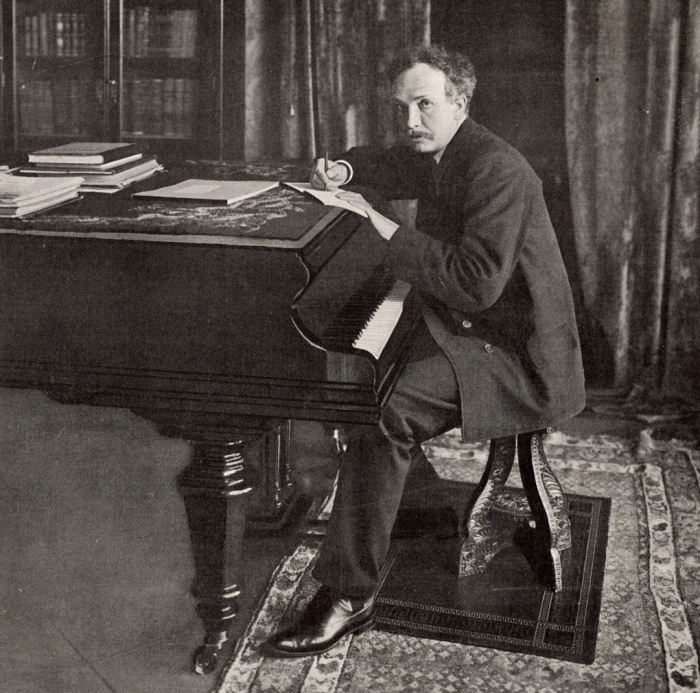
On 17 June 1935, Strauss wrote a letter to Stefan Zweig, in which he stated:
Do you believe I am ever, in any of my actions, guided by the thought that I am ‘German’? Do you suppose Mozart was consciously ‘Aryan’ when he composed? I recognise only two types of people: those who have talent and those who have none.
This letter to Zweig was intercepted by the Gestapo and sent to Hitler. Strauss was subsequently dismissed from his post as Reichsmusikkammer president in 1935. The 1936 Berlin Summer Olympics nevertheless used Strauss’s Olympische Hymne, which he had composed in 1934. Strauss’s seeming relationship with the Nazis in the 1930s attracted criticism from some noted musicians, including Arturo Toscanini, who in 1933 had said, “To Strauss the composer I take off my hat; to Strauss the man I put it back on again,” when Strauss had accepted the presidency of the Reichsmusikkammer. Much of Strauss’s motivation in his conduct during the Third Reich was, however, to protect his Jewish daughter-in-law Alice and his Jewish grandchildren from persecution. Both of his grandsons were bullied at school, but Strauss used his considerable influence to prevent the boys or their mother being sent to concentration camps.
Friedenstag
In 1938, when the entire nation was preparing for war, Strauss created Friedenstag (Peace Day), a one-act opera set in a besieged fortress during the Thirty Years’ War. The work is essentially a hymn to peace and a thinly veiled criticism of the Third Reich. With its contrasts between freedom and enslavement, war and peace, light and dark, this work has a close affinity with Beethoven’s Fidelio. Productions of the opera ceased shortly after the outbreak of war in 1939.
When his Jewish daughter-in-law Alice was placed under house arrest in Garmisch-Partenkirchen in 1938, Strauss used his connections in Berlin, including opera-house General Intendant Heinz Tietjen, to secure her safety. He drove to the Theresienstadt concentration camp (Terezín), Czech Republic in order to argue, albeit unsuccessfully, for the release of his son Franz’s Jewish mother-in-law, Marie von Grab. Strauss also wrote several letters to the SS pleading for the release of her children who were also held in camps; his letters were ignored.
In 1942, Strauss moved with his family back to Vienna, where Alice and her children could be protected by Baldur von Schirach, the Gauleiter of Vienna. However, Strauss was unable to protect his Jewish relatives completely; in early 1944, while Strauss was away, Alice and his son Franz were abducted by the Gestapo and imprisoned for two nights. Strauss’s personal intervention at this point saved them, and he was able to take them back to Garmisch, where the two remained under house arrest until the end of the war.
Metamorphosen
Strauss completed the composition of Metamorphosen, a work for 23 solo strings, in 1945. The title and inspiration for the work comes from a profoundly self-examining poem by Goethe, which Strauss had considered setting as a choral work.Generally regarded as one of the masterpieces of the string repertoire, Metamorphosen contains Strauss’s most sustained outpouring of tragic emotion. Conceived and written during the blackest days of World War II, the piece expresses Strauss’s mourning of, among other things, the destruction of German culture—including the bombing of every great opera house in the nation. At the end of the war, Strauss wrote in his private diary:
The most terrible period of human history is at an end, the twelve year reign of bestiality, ignorance and anti-culture under the greatest criminals, during which Germany’s 2000 years of cultural evolution met its doom.
In April 1945, Strauss was apprehended by American soldiers at his Garmisch estate. As he descended the staircase he announced to Lieutenant Milton Weiss of the U.S. Army, “I am Richard Strauss, the composer of Rosenkavalier and Salome.” Lt. Weiss, who was also a musician, nodded in recognition. An “Off Limits” sign was subsequently placed on the lawn to protect Strauss. The American oboist John de Lancie, who knew Strauss’s orchestral writing for oboe thoroughly, was in the army unit, and asked Strauss to compose an oboe concerto. Initially dismissive of the idea, Strauss completed this late work, his Oboe Concerto, before the end of the year.
Last works
The metaphor “Indian Summer” is often used by journalists, biographers, and music critics to describe Strauss’s late creative upsurge from 1942 to the end of his life. The events of World War II seemed to bring the composer—who had grown old, tired, and a little jaded—into focus. The major works of the last years of Strauss’s life, written in his late 70s and 80s, include, among others, his Horn Concerto No. 2, Metamorphosen, his Oboe Concerto, and his Four Last Songs.
The Four Last Songs, composed shortly before Strauss’s death, deal with the subject of dying. The last, “At Sunset” (Im Abendrot), ends with the line “Is this perhaps death?” The question is not answered in words, but instead Strauss quotes the “transfiguration theme” from his earlier tone poem, Death and Transfiguration – meant to symbolize the transfiguration and fulfillment of the soul after death.
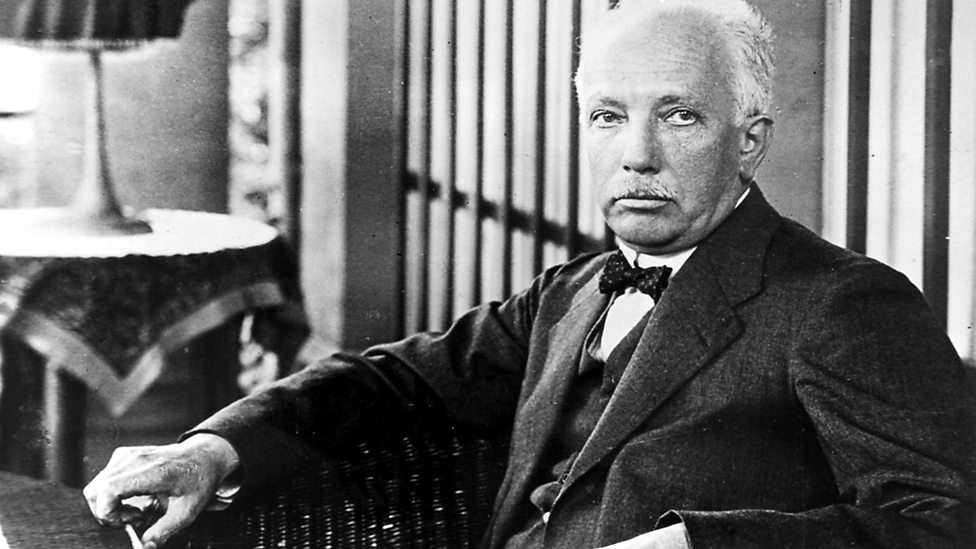
Death and legacy
Strauss died at the age of 85 on 8 September 1949, in Garmisch-Partenkirchen, Germany. Georg Solti, who had arranged Strauss’s 85th birthday celebration, also directed an orchestra during Strauss’s burial. The conductor later described how, during the singing of the famous trio from Rosenkavalier, “each singer broke down in tears and dropped out of the ensemble, but they recovered themselves and we all ended together.” Strauss’s wife, Pauline de Ahna, died eight months later, on 13 May 1950, at the age of 88.
During his lifetime Strauss was considered the greatest composer of the first half of the 20th century, and his music had a profound influence on the development of 20th-century music. There were few 20th-century composers who compared with Strauss in terms of orchestral imagination,[neutrality is disputed] and he made a significant contribution to the history of post-Wagnerian opera. Strauss’s late works, modelled on “the divine Mozart at the end of a life full of thankfulness,” are widely considered the greatest works by any octogenarian composer.
Strauss himself declared in 1947 with characteristic self-deprecation: “I may not be a first-rate composer, but I am a first-class second-rate composer.” The Canadian pianist Glenn Gould described Strauss in 1962 as “the greatest musical figure who has lived in this century.”
Until the 1980s, Strauss was regarded by some post-modern musicologists as a conservative, backward-looking composer, but re-examination of and new research on the composer has re-evaluated his place as that of a modernist, albeit one who still utilized and sometimes revered tonality and lush orchestration. Strauss is noted for his pioneering subtleties of orchestration, combined with an advanced harmonic style, advances which influenced the composers who followed him.
Strauss has always been popular with audiences in the concert hall and continues to be so. He has consistently been in the top 10 composers most performed by symphony orchestras in the USA and Canada over the period 2002-2010. He is also in the top 5 of 20th Century composers (born after 1860) in terms of the number of currently available recordings of his works.
Strauss as a conductor
Strauss, as conductor, made a large number of recordings, both of his own music as well as music by German and Austrian composers. His 1929 performances of Till Eulenspiegel and Don Juan with the Berlin State Opera Orchestra have long been considered the best of his early electrical recordings. In the first complete performance of his An Alpine Symphony, made in 1941 and later released by EMI, Strauss used the full complement of percussion instruments required in this symphony
Koch Legacy has also released Strauss’s recordings of overtures by Gluck, Carl Maria von Weber, Peter Cornelius, and Wagner. The preference for German and Austrian composers in Germany in the 1920s through the 1940s was typical of the German nationalism that existed after World War I. Strauss clearly capitalized on national pride for the great German-speaking composers.
There were many other recordings, including some taken from radio broadcasts and concerts, during the 1930s and early 1940s. The sheer volume of recorded performances would undoubtedly yield some definitive performances from a very capable and rather forward-looking conductor.
In 1944, Strauss celebrated his 80th birthday and conducted the Vienna Philharmonic in recordings of his own major orchestral works, as well as his seldom-heard Schlagobers (“Whipped Cream”) ballet music. Some find more feeling in these performances than in Strauss’s earlier recordings, which were recorded on the Magnetophon tape recording equipment. Vanguard Records later issued the recordings on LPs. Some of these recordings have been reissued on CD by Preiser.
Strauss also made live-recording player piano music rolls for the Hupfeld system and in 1906 ten recordings for the reproducing piano Welte-Mignon all of which survive today. Strauss was also the composer of the music on the first CD to be commercially released: Deutsche Grammophon’s 1983 release of their 1980 recording of Herbert von Karajan conducting the Alpine Symphony.
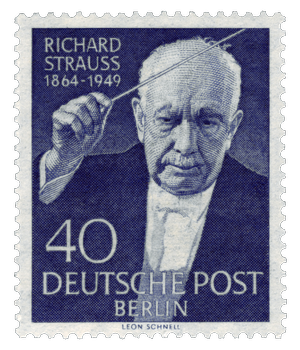
Modern critical reception of selected recordings conducted by Strauss
Pierre Boulez has said that Strauss the conductor was “a complete master of his trade”. Music critic Harold C. Schonberg says that, while Strauss was a very fine conductor, he often put scant effort into his recordings. Schonberg focused primarily on Strauss’s recordings of Mozart’s Symphony No. 40 and Beethoven’s Symphony No. 7, as well as noting that Strauss played a breakneck version of Beethoven’s 9th Symphony in about 45 minutes. Concerning Beethoven’s 7th Symphony, Schonberg wrote, “There is almost never a ritard or a change in expression or nuance. The slow movement is almost as fast as the following vivace; and the last movement, with a big cut in it, is finished in 4 minutes, 25 seconds. (It should run between 7 and 8 minutes.)” He also complained that the Mozart symphony had “no force, no charm, no inflection, with a metronomic rigidity.”
Peter Gutmann’s 1994 review for ClassicalNotes.com says the performances of the Beethoven 5th and 7th symphonies, as well as Mozart’s last three symphonies, are actually quite good, even if they are sometimes unconventional. Gutmann wrote:
It is true, as the critics suggest, that the readings forego overt emotion, but what emerges instead is a solid sense of structure, letting the music speak convincingly for itself. It is also true that Strauss’s tempos are generally swift, but this, too, contributes to the structural cohesion and in any event is fully in keeping with our modern outlook in which speed is a virtue and attention spans are defined more by MTV clips and news sound bites than by evenings at the opera and thousand page novels.
More
Son of Franz Joseph Strauss, a musician at the Court Orchestra in Munich and a daughter from the Pschorr family of brewers. He grew up in a conservative environment and was supported by Hans von Bülow in his early years. Bülow employed him as assistant conductor in Berlin, until he became conductor in Meiningen after Bülow resigned there.
As a young man Strauss had seen a repetition by Richard Wagner at Bayreuth and he felt a deep admiration for the composer and his work during his whole life. In 1889 he met Wagner’s widow Cosima when he worked as a musical assistant for the Opera “Parsifal” at Bayreuth. His own opera “Guntram” was meant to honour the master, but it wasn’t liked by Cosima and her circle.
In 1894 he married the singer Pauline de Ahna, who was disliked by most people they knew because of her rude manners. But it was a good marriage and her bad temper was always easily forgotten by Strauss. In 1897 they had a son, Franz.
In 1905 his opera “Salome”, with a libretto by Hugo von Hofmannsthal, was first performed in Dresden. It was an instant succes and the royalties enabled the shrewd businessman Strauss to build a villa in Garmisch. His next success together with Hofmansthal was “Elektra” (1909) and in 1911 “Der Rosenkavelier” was equally well received although completely different in style. Apart from his opera’s Strauss was well known for his impressive symphonic poems.
After the nazis came to power it seems that he believed genuinely that they would support German music. He shared their distaste of Jewish culture and although he was never politically involved with the Third Reich, he accepted the presidency of the Reichsmusikkammer (The State Office of Music). He was in contact with several nazis and happily accepted well paid assignments. It is possible that he also wanted to protect his daughter in law Alice, who was half Jewish. He lost his post as president after he had denounced the nazis in a letter to his Jewish librettist Stefan Zweig, who lived in Austria. Zweig had succeeded Hofmannshal, who had died in 1929 of a stroke two days after his son had committed suicide.
In 1942 Strauss moved to Vienna, where he had a house since his conducting engagement there in earlier years. In Vienna he was in close contact to Baldur von Schirach, the Gauleiter of Vienna. He was back in Garmisch when the Americans invade Germany. He was placed under the protection of the army, but after the war he was heavily criticized for his collaboration and he felt forced to move to Switzerland. He was an old man now and illnesses forced him to cure frequently.
- 07-10-1897 in Amsterdam Royal Concertgebouw.
- 10-10-1897 in Amsterdam Royal Concertgebouw.
- 26-10-1899 Ein Heldenleben by Richard Strauss (1864-1949) is in 1898 dedicated to Amsterdam Royal Concertgebouw Orchestra (RCO) in appreciation for the excellent performance of the orchestra in 1897. 26-10-1899: First performance in Amsterdam with conductor Willem Mengelberg (1871-1951).
- 05-10-1904. Symphonia Domestica

